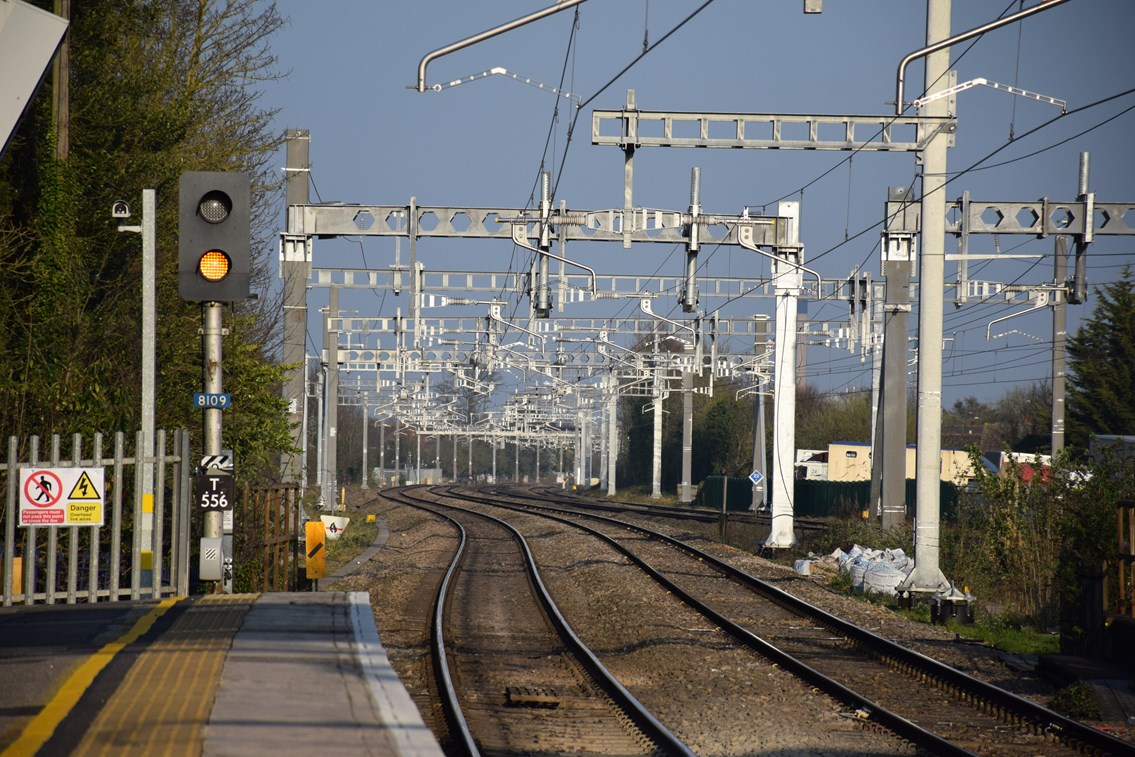Tuesday 28 Mar 2017
New trains on the way as Thames Valley electrification reaches major milestone
- Region & Route:
- Wales & Western: Western
- | Wales & Western
- Network Rail successfully electrifies 12 miles of railway from Maidenhead to Stockley Junction as part of the Crossrail project
- New electric infrastructure in the Thames Valley allows for the introduction of new Great Western Railway (GWR) trains in May and the Elizabeth line from 2019
- Click here to download images of the work; click here to view a short video
Last weekend, Network Rail successfully electrified 12 miles of railway to the west of London between Stockley Junction and Maidenhead as part of the Crossrail project.
Electrification will allow GWR to extend new electric trains from London Paddington to Maidenhead from this May, and to Didcot in January 2018, delivering more seats for passengers. In January this year GWR began to run half-hourly new Electrostar trains from London Paddington to Hayes & Harlington, providing much needed extra capacity for passengers.
The work will also allow for the delivery of new Elizabeth line trains on this section of the railway from December 2019. Passengers in the Thames Valley will be able to catch new Elizabeth line trains all the way through central London without having to change onto the Underground at Paddington, making it quicker and easier to get to a range of destinations across London and the South East.
Over three years, Network Rail has led an 800-strong workforce to successfully install more than 1,400 overhead structures and 140 miles of overhead wires that will power the new trains. The vast majority of this huge engineering project had to be undertaken in the early hours of the morning, at weekends and bank holidays to enable GWR and other operators to run normal services as much as possible.
Mark Langman, Route Managing Director, Network Rail, said: “This is a major milestone for Network Rail’s Railway Upgrade Plan of which the delivery of an electrified Great Western Mainline and the Elizabeth line is a huge part. From May this year more passengers will see immediate benefits with brand new, cleaner, quieter electric trains operating between Maidenhead and Paddington. “On behalf of Network Rail I would like to thank passengers, local residents, businesses and local authorities for their patience and permission to deliver this huge programme of railway upgrade work at anti-social hours, weekends and every bank holiday for the last three years. Without their support it simply would not have been possible to electrify the Great Western Mainline to deliver new improved passenger services and pave the way for the Elizabeth line.”
Mark Hopwood, GWR Managing Director, said: “The Thames Valley is one of the most popular rail corridors in the UK. We have promised the current fleet would be upgraded to provide much needed additional capacity and more comfortable, quieter journeys. We started to run half hourly new electric trains in January, delivering over 10,000 more seats a day between London Paddington and Hayes & Harlington. We look forward to being able to extend these services beyond Hayes to Maidenhead this coming May as Network Rail continues its work to upgrade the railway.”
Matthew White, Crossrail Surface Director, said: “The completion of this major piece of work paves the way for new, quicker, quieter trains right along this stretch of the railway. Once the Elizabeth line opens fully in 2019, passengers from the Thames Valley will be able to catch one train all the way through central London, providing a direct link to a range of destinations, including the West End, the City and Canary Wharf.”
ENDS
Notes to Editors
About Crossrail and Network Rail
Network Rail is a key partner in delivering the Crossrail project. It is responsible for the design, development and delivery of the parts of the Elizabeth line route that are on the existing rail network. Network Rail’s work, which will integrate the new rail tunnels beneath London with the existing rail network, includes upgrades to track, major civil engineering projects, new overhead electrification equipment and improvements to stations and bridges.
The route will pass through 40 stations from Reading and Heathrow in the west, through new twin-bore 21 km tunnels to Shenfield and Abbey Wood in the east. The Transport for London (TfL) run railway will be named the Elizabeth line when services through central London open in December 2018. The Crossrail project is being delivered by Crossrail Limited, a wholly owned subsidiary of TfL, and is jointly sponsored by the Department for Transport and TfL.
Contact information
Passengers / community members
Network Rail national helpline
03457 11 41 41
Latest travel advice
Please visit National Rail Enquiries
Journalists
Network Rail press office -Western route
MediaRelationsWestern@networkrail.co.uk
About Network Rail
We own, operate and develop Britain's railway infrastructure; that's 20,000 miles of track, 30,000 bridges, tunnels and viaducts and the thousands of signals, level crossings and stations. We run 20 of the UK's largest stations while all the others, over 2,500, are run by the country's train operating companies.
Usually, there are almost five million journeys made in the UK and over 600 freight trains run on the network. People depend on Britain's railway for their daily commute, to visit friends and loved ones and to get them home safe every day. Our role is to deliver a safe and reliable railway, so we carefully manage and deliver thousands of projects every year that form part of the multi-billion pound Railway Upgrade Plan, to grow and expand the nation's railway network to respond to the tremendous growth and demand the railway has experienced - a doubling of passenger journeys over the past 20 years.
Follow us on Twitter: @networkrail
Visit our online newsroom: www.networkrailmediacentre.co.uk

